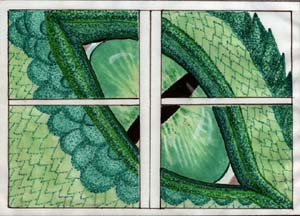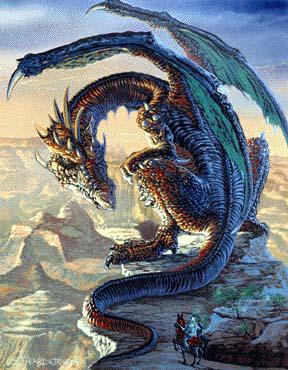
Dragons Are The True Ancients....
A Little Dragon Lore
Before mortal humankind slithered it's way out of the primordial ooze Dragons existed
and were respected and revered in the NetherWorld. Mortals have been a bain to Dragons
because of ignorance and fear, and the majority misjudge the true nature of these majestic
creatures. The sages and wizards knew the vast knowledge and power of Dragons,
and respected their puissance.

Ancient Dragon Types:
Egyptian: Many believe this is the era in history where the dragon originated. In early Egypt the Dragon was chiefly a representation of the snake. In Egyptian myth "Re" (the sun god) traveled through Duat (the underworld) each night. During the journey through the underworld Re reaches two open doors guarded by snakes, some having human heads and four legs others having three snake heads and wings. Re passes by these without incident as they are only guards. Later Re observes the demise of Apophis, the giant serpent representing chaos, whose severed coils are bound by Aker, a Dragon representing the Earth. There are many occurrences of Dragons in Egyptian mythology, another example being Denwen. Denwen was attested in the third millennium B.C. and is described as a fiery serpent who would have caused a conflagration destroying all of the gods if it had not been thwarted by the King.
Amphitptere: Thought to be one of the oldest varities of Dragon, the Amphitptere was a winged serpent-type without legs. In ancient history it was recorded in Egypt and in Arabia. Many believed that it guarded the precious Frankincense trees, from which a resin comes that is used in many cultures for religious purposes.
Babylonian: The Babylonian Dragon is found in the Epic of Creation from the early second millennium B.C. It details the struggle of "Apsu" (god of the primordial waters under the earth) and "Tiamat" (the sea) against their son "Ea". Apsu is defeated by Ea who takes over his domain and produces a son, the god-hero "Marduk". Tiamat created all sorts of Dragons, including the Mushussu Dragon, in order to have her revenge, but she is defeated in single combat by Marduk and her body is split to form the earth and the sky. The Mushussu is subdued by Marduk and takes it's place at his feet. These images were relatively short lived however, as the Chinese Lung types soon came to dominate in later Near Eastern mythology.
Lindworm: The Lindworm had a serpentine-type body, one pair of legs, and it was wingless, therefore, it could not fly. Lindworms were found in Central Asia.
Heraldic: The Heraldic is probably the most well known Dragon. The Heraldic has dangerous fangs, four legs complete with claws, and a ridge of sharp spines that run from it's head to it's tail tip.
Guivre: The Guivre was both legless and wingless, and appeared somewhat serpent-like in appearence. Its head had horns and it's jaw was bearded. It favored any location near water.
Indian: In early India, images of the Dragon were in some ways similar to the Egyptian ones in that they resembled the snake. There were those, however, that represented the form of the crocodile, such as the "Makara". In Hindu myth the Indians identified the Dragon with nature. One of the Indian Dragons, "Vritra", caused drought by withholding water in its body until it is slain by Indra, god of rain, with a bolt of lightning thus starting the monsoon. While there are many similarities with the Egyptian images, we can also see influences from the Chinese Lung type.
Islamic: Dragons in the Islamic world initially started out as astronomical figures, and were linked to the Egyptian myth of Re's voyage through the underworld. The Dragon "Jawzahr" was thought to be responsible for eclipses and comets. The Dragons "Draco" and "Serpentarius" were emblazoned in the stars. There are many tales in Persian mythology of Dragons representing evil being slain by heroes, influenced by the Greek legends. It is from this that the idea of Dragons guarding treasure emerges, the treasure eventually passing to the King who represents good. This, however, was not to last. (When the Mongols invaded Persia they imposed their own Chinese style images).
Chinese: Chinese dragons are snake-like with scales and four short legs extending with clawed feet. Chinese dragons have five toes, the Korean Dragon has four toes, and the Japanese has three toes. (The five toed dragons are considered a symbol of power) They are wingless. They are often depicted as colored either green, red, or gold, but other colors are found. The Chinese term for the dragons is "Lung". (The Lung had it's origins in the oracle bones of the Shang and the I'Ching) There are four major categories of Lung:
Tien-Lung: The Celestial Dragon, who protects the places of Gods.
Shen-Lung: The Spiritual Dragon, who controls wind and rain.
Ti-lung: The Earth Dragon, which controls rivers, and water on the Earth.
Fut’s-Lung: The Underworld Dragon, which guards precious metals and gems.
Japanese: The Japanese dragon is the Ryu, said to be able to live in the air, water, or on land. It was considered one of the four sacred creatures of the Orient, and it symbolizes rain and storms.
European: These dragons were found in early Greek, Roman, Norse, and medieval legends. They had wings, two or four legs, and depending on the type color can vary. They were believed to breath fire. Sadly, many Europeans considered the dragon to be evil and malevolent, however, the Greeks held the idea of the Dragon as a Guardian Serpent. Some examples of these dragons are:
Fafnir: A Norse dragon who was guardian of the treasure later known as the Nibelung hoard.
Hydra: Some are Hyrda was a dragon, others argue not. Hyrda had several heads, the center one was said to be immortal. (When one of the hydra's heads was cut off two grew in its place) It was said to haunt the marshes of Lerna near Argos. The destruction of the hydra was one of the twelve labors of Hercules.
Wyvern: The Wyvern was a feared Dragon of Britain, for the the Europeans believed it to be evil and vicious. It had a coiling trunk that had a pair of birds-type legs which were tucked beneath it's wings.
Tatzlwyrm: A winged, fire-breathing dragon.
Mayan and Aztec: The Mayan "Kukulkan", later the Aztec "Quetzalcoatl", was both good and evil, and it was thought to rule the four parts of the Earth. The greatest god of the Aztecs was "Xiuhtecuhtli" who took on many manifestations, one of which being the fire serpent. There are parallels with the Chinese myths in that Quetzalcoatl is described as being able to take the form of the Sun and is depicted as being swallowed by the Earth serpent thus causing an eclipse.
African: The "Amphisbaena" was a two-headed dragon (one at the front, and one on the end of its tail). The front head would hold the tail (or neck as the case may be) in its mouth, creating a circle that allowed it to roll.
Under Construction...

Dancing Dragons by C. A. Adams
Dragons dance across my dreams,
Amongst shadows of magical scenes.
Nymphs, fairies and sprites weave woodland magic.
Castles and Citadels beckon you to come explore.
Illusions being conjured up by powerful wizards?
Nightfall and a full moon bring life to stone,
Gargoyles glide down from their high thrones.
Druids encircle a field of once mighty warriors,
Rusting armor and broken swords lie still,
Amongst their shattered skulls and sun bleached bones.
Gemstones from their weapons pay the fare of the,
Ominous looking ferryman Charon.
Nerves of steel and willpower of a saint are needed as,
Sorcerer and Sorceress tempt you into their towers.
Those Dancing Dragons sense your danger and the
Love for them in your heart.
They swoop in and carry you off away from all that,
brings harm your way.
So with a heart full of love you say thanks to those,
beautiful Dancing Dragons and awake from our dreams.

This site owned by
Morgana
 and LadyDragon
and LadyDragon
 EMail Morgana
EMail Morgana
 EMail LadyDragon
EMail LadyDragon





















